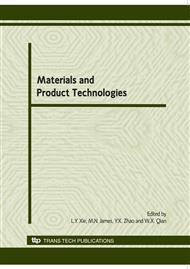[1]
European Union Directive Waste Framework Directive (EEC) 75/442 15th July (1975).
Google Scholar
[2]
Ding, L and Matthews, J. A: Computers and Industrial Engineering, Vol 57(4), p.1457 (2009).
Google Scholar
[3]
Matthews J, Ding L, Singh B, Mullineux G and Medland A. J: Advances in Materials Research. 44-46: pp.659-668.
Google Scholar
[4]
Stirk, D 2009 A feasibility study into practical techniques to measure power usage during machining. Masters of Engineering Dissertation. University of Bath, Bath, UK.
Google Scholar
[5]
Allen, S. R; Hammond, G. P and McManus, M. C Proceedings of the Institution of Mechanical Engineers part A-Journal of Power and Energy, Vol 222 (7), p.669 (2008).
Google Scholar
[6]
O'Brien, C 1999 International Journal of production economics, 60-61: 1 (1999).
Google Scholar
[7]
Meadows, D. H: The Limits to growth. A report for the Club of Rome's project on the predicament for mankind Universe Books, New York ISBN-10: 0876639015 (1974).
Google Scholar
[8]
Lee, M.W., Ong, R., Cheach, I., Pritchard, M., Yong, J. M. s and Clegg, A 2006. SIMtech technical reports. 7 (1): p.26 (2006).
Google Scholar
[9]
O'Brien, C: International Journal of production research, 40: 3867 (2002).
Google Scholar
[10]
Munoz A. A: Journal of Materials Processing Technology, 53: p.736 (1994).
Google Scholar
[11]
Young, P. Byrne, G., Cotterell, M: The International Journal of Advanced Manufacturing Technology 13(7), p.488 (1997).
Google Scholar
[12]
Krishnana, N. and Sheng, P.S. 2000 Environmental versus Conventional planning for machined components CIRP Annals - Manufacturing Technology 49(1): p.363 (2000).
DOI: 10.1016/s0007-8506(07)62965-5
Google Scholar
[13]
Mouzon, G and Ylidrim , M, B: Journal of Sustainable Engineering, 1(2): p.105 (2008).
Google Scholar
[14]
Dietmar, A and Verl, A 2009 A generic energy consumption model for decision making and energy efficiency optimisation in manufacturing. Journal of Sustainable Engineering, 2(2): p.123 (2009).
DOI: 10.1080/19397030902947041
Google Scholar
[15]
Oberk, E: Machinery's handbook: a reference book for the mechanical engineer, designer, manufacturing engineer, draftsman tool maker and machinist Industrial Press, New York (2004).
Google Scholar
[16]
Ding, L., Matthews, J., McMahon, C and Mullineux, G: Concurrent Engineering: Research and Applications, 17 (2), p.103 (2009).
Google Scholar
[17]
Koelsch, J. R: Manufacturing Engineering. September 08 Issue Vol 141(3) (2008).
Google Scholar
[18]
Ijomah W. L: International Journal of Computer Integrated Manufacture, 1 - 26, 21 (6): p.676 (2008).
Google Scholar
[19]
Sreejith, P. S and Ngoi, B.K. A 2000. Dry Machining: machining of the future. Journal of materials processing Technology, 101 p.287 (2000).
DOI: 10.1016/s0924-0136(00)00445-3
Google Scholar
[20]
Richardson, D.J., Keavey M.A. and Dailami, F. Modelling. International Journal of Machine Tools & Manufacture 46: p.1139 (2006).
DOI: 10.1016/j.ijmachtools.2005.08.008
Google Scholar


